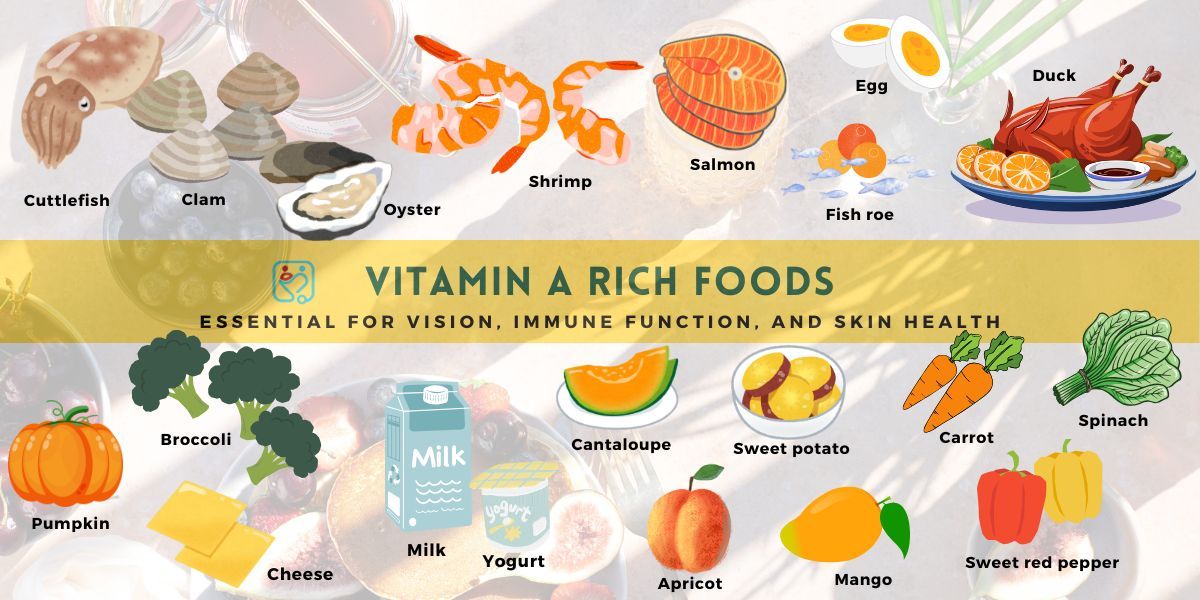
What Are The Benefits Of Vitamin A?
Vitamin A is a fat-soluble vitamin crucial for vision, immune function, cell growth, and reproduction. It comes in two main forms: preformed vitamin A (retinol), found in animal products, and provitamin A carotenoids (like beta-carotene), found in plant-based foods. Ensuring you get enough vitamin A is essential for maintaining optimal health.
- Vision: especially night vision.
- Immune function: it supports a healthy immune system.
- Cell growth and development: it plays a role in cell differentiation.
- Reproductive health: it's important for both male and female reproductive health.
- Skin health: it helps maintain healthy skin.
NIH (National Institutes of Health) recommends the daily amount of vitamin A, it is expressed in Retinol Activity Equivalents (RAE) to account for the different bioactivities of retinol and provitamin A carotenoids, all of which are converted by the body into retinol. One mcg RAE is equivalent to 1 mcg retinol, 2 mcg supplemental beta-carotene, 12 mcg dietary beta-carotene, or 24 mcg dietary alpha-carotene or beta-cryptoxanthin.
- Birth to 6 months: 400 mcg RAE
- Infants 7-12 months: 500 mcg RAE
- Children 1-3 years: 300 mcg RAE
- Children 4-8 years: 400 mcg RAE
- Children 9-13 years: 600 mcg RAE
- Teen and adult men: 900 mcg RAE
- Teen and adult women: 700 mcg RAE
- Pregnant women: 800 mcg RAE
- Breastfeeding women: 1300 mcg RAE
These recommendations ensure adequate vitamin A levels for supporting vision, immune function, and cell growth, and it's important to obtain these amounts through a balanced diet or, when necessary, through careful supplementation under medical guidance to avoid potential toxicity from excessive intake.
Where Can You Find Vitamin A?
Vitamin A is found in a wide variety of foods, making it easy to incorporate into your diet. Let's explore the delicious foods that can help you meet your vitamin A needs. According to the USDA database, a 3.5-ounce (100-gram) raw portion provides the following nutritional information:
Animal Food, Best Sources
- 1 Goose egg (144g): 269 mcg RAE
- Chicken liver pate: 218 mcg RAE
- Fish, sturgeon: 210 mcg RAE
- 1 Chicken egg, grade A (50.3g): 180 mcg RAE
- 1 Turkey egg (79g): 166 mcg RAE
- 1 Duck egg (70g): 136 mcg RAE
- Cuttlefish: 113 mcg RAE
- 1 Chicken egg, jumbo (63g): 101 mcg RAE
- Clam: 90 mcg RAE
- Fish, roe: 90 mcg RAE
- 1 Chicken egg, extra large (56g): 89.6 mcg RAE
- Oyster: 81 mcg RAE
- 1 Chicken egg, large (50g): 80 mcg RAE
- Quail: 73 mcg RAE
- 1 Chicken egg, medium (44g): 70.4 mcg RAE
- 1 Chicken egg yolk, large (17g): 64.8 mcg RAE
- 1 Chicken egg, small (38g): 60.8 mcg RAE
- Fish, salmon: 58 mcg RAE
- Shrimp: 54 mcg RAE
- Duck: 50 mcg RAE
Plant-Based Food, Best Sources
- Sweet potato: 709 mcg RAE
- Carrot, baby: 690 mcg RAE
- Turnip greens: 579 mcg RAE
- Dandelion greens: 508 mcg RAE
- Spinach: 469 mcg RAE
- Pumpkin: 426 mcg RAE
- Lettuce, cos or romaine: 436 mcg RAE
- Winged bean leaves: 405 mcg RAE
- Vinespinach, (basella): 400 mcg RAE
- Lettuce, red leaf: 375 mcg RAE
- Lettuce, green leaf: 370 mcg RAE
- Garden cress: 346 mcg RAE
- Beet greens: 316 mcg RAE
- Water convolvulus: 315 mcg RAE
- Swiss chard: 306 mcg RAE
- Chicory greens: 286 mcg RAE
- Collard greens: 251 mcg RAE
- Kale: 241 mcg RAE
- Cabbage, chinese (pak-choi): 223 mcg RAE
- Chives: 218 mcg RAE
- Celtuce: 175 mcg RAE
- Cantaloupe: 169 mcg RAE
- Lettuce, butterhead: 166 mcg RAE
- Watercress: 160 mcg RAE
- Sweet red pepper: 157 mcg RAE
- Mustard greens: 151 mcg RAE
- Soy milk, 1 cup (244g): 142 mcg RAE
- Broccoli raab: 131 mcg RAE
- Arugula: 119 mcg RAE
- Endive: 108 mcg RAE
- Taro: 102 mcg RAE
- Almond milk, 1 cup (244g): 101 mcg RAE
- Prune puree: 100 mcg RAE
- Apricot: 96 mcg RAE
- Persimmon: 81 mcg RAE
- Orange tomato: 75 mcg RAE
- Winter squash: 68 mcg RAE
- Passion-fruit (granadilla): 64 mcg RAE
- Grapefruit, pink and red: 58 mcg RAE
- Red cabbage: 56 mcg RAE
- Mango: 54 mcg RAE
- Savoy cabbage: 50 mcg RAE
- Tofu: 50 mcg RAE
Diary Food, Best Sources
- Butter: 684 mcg RAE
- Cheese, goat: 486 mcg RAE
- Cheese, limburger: 340 mcg RAE
- Cheese, cheddar: 337 mcg RAE
- Cheese, gjetost: 334 mcg RAE
- Cheese, port de salut: 315 mcg RAE
- Cheese, cream: 308 mcg RAE
- Cheese, muenster: 298 mcg RAE
- Cheese, roquefort: 294 mcg RAE
- Cheese, brick: 292 mcg RAE
- Cheese, swiss: 288 mcg RAE
- Cheese, gruyere: 271 mcg RAE
- Cheese, parmesan: 228 mcg RAE
- Cheese, monterey: 198 mcg RAE
- Cheese, blue: 198 mcg RAE
- Cheese, mozzarella: 179 mcg RAE
- Cheese, ricotta: 127 mcg RAE
- Cheese, feta: 125 mcg RAE
- Sour cream: 119 mcg RAE
- Whole milk, 1 cup (244g): 112 mcg RAE
- Milk, 1 cup (244g): 34.2 mcg RAE
- Yogurt: 27 mcg RAE